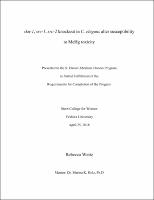Please use this identifier to cite or link to this item:
https://hdl.handle.net/20.500.12202/4516| Title: | skn-1, src-1, src-2 knockout in C. elegans alter susceptibility to MeHg toxicity. |
| Authors: | Holz, Marina K. Weitz, Rebecca |
| Keywords: | senior honors thesis skn-1 src-1 src-2 C. elegans MeHg Toxicity |
| Issue Date: | 25-Apr-2018 |
| Publisher: | Stern College for Women Yeshiva University. |
| Citation: | Weitz, Rebecca. skn-1, src-1, src-2 knockout in C. elegans alter susceptibility to MeHg toxicity Presented to the S. Daniel Abraham Honors Program in Partial Fulfillment of the Requirements for Completion of the Program Stern College for Women Yeshiva University April 25, 2018. |
| Abstract: | Methylmercury (MeHg) is a highly toxic organometal found in the environment. Humans are exposed to methylmercury through consumption of contaminated fish and plants, as well as through occupational exposure and anthropogenic mercury emissions. It has been previously shown that methylmercury causes an oxidative stress response in our cells. The transcription factor, nuclear factor erythroid 2-related factor 2 (Nrf-2), acts to combat this oxidative stress by moving into the nucleus and promoting cytoprotective gene expression. When Nrf-2 levels are high, Fyn and other Src family kinases move into the nucleus and phosphorylate Nrf-2. This results in Nrf-2 export out of the nucleus and a subsequent down regulation of the oxidative stress response. The animal model C. elegans has homologs for these genes and has many conserved molecular pathways shared across species. In this study, we examined strains that had mutations for skn-1 (Nrf-2 homolog), src-1 (Src homolog), and src-2 (Fyn homolog). We hypothesized that without src-1 or src-2 present, there will be persistent skn- 1 activity, leading to greater protection against methylmercury toxicity. To establish relevant dose exposure for our strains, we performed a lethality assay. We exposed L1 stage worms to doses of methylmercury ranging from 0 - 100 μM and treated for one hour. After treatment, 20-30 worms were plated in triplicate and the percent of worms alive 48 hours later was recorded. After establishing LD50 values for each strain (wild type: 46.61μM, skn-1 KO: 39μM, src-2 KO: 45.23μM, src-1 KO: 35.68μM), we chose 20μM as the sublethal dosage for subsequent experiments. We performed qPCR assays to examine gene expression levels comparing methyl mercury treated and untreated worms. This assay was used to investigate how src family kinases differ between strains and how the cytoprotective genes differ due to treatment and genetic background. We were specifically interested in gst-4, sod-1, src-1, and src-2 (gst-4 and sod-1 are cytoprotective skn-1 target genes, while src-1 and src-2 are src family kinases). Our results from the qPCR thus far have been inconclusive. Perhaps the dose level is too low and/or the time point is too far from the time of treatment. Additional replicates are needed for this assay. Our results from the lethality assay were consistent with previous research showcasing that knockout of skn-1 led to increased susceptibility against methylmercury toxicity when compared to wild type. Contrary to our hypothesis, knockout of src-2 was comparable to wild type and knockout of src-1 led to increased susceptibility to MeHg. It is conceivable that knockout of src-1 or src-2 led to compensatory upregulation of src-2 or src-1, respectively. Because of the dramatic leftward shift of the src-1 knockout and the comparability of the lethality curves of the src-2 knockout to the wild type, we speculate that src-2, the homolog to Fyn, is the stronger src family inhibitor of skn-1. Further replication of the qPCR, as well as other additional assays, are required to justify our speculation. |
| Description: | The file is restricted for YU community access only. |
| URI: | https://hdl.handle.net/20.500.12202/4516 https://ezproxy.yu.edu/login?url=https://repository.yu.edu/handle/20.500.12202/4516 |
| Appears in Collections: | S. Daniel Abraham Honors Student Theses |
Files in This Item:
| File | Description | Size | Format | |
|---|---|---|---|---|
| Weitz Honors Thesis.pdf Restricted Access | The file is restricted for YU community access only. | 574.54 kB | Adobe PDF |  View/Open |
This item is licensed under a Creative Commons License

